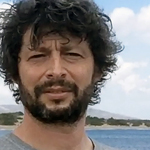Lake Tanganyika, the eastern Tanzanian shoreline near Bulu Point
72nd place in Biotope Aquarium Design Contest 2017
![]() Germany. Anke Morbitzer
Germany. Anke Morbitzer

Volume: 900 L
Dimensions: 250x60x60 cm
List of fishes: Tropheus moori “Bulu Point”, Neolamprologus leleupi, Altolamprologus calvus, Synodontis petricola, Cyphotilapia frontosa
List of plants: Vallisneria gigantea
Description of decorations: We used around 200kg of tumbled limestone, which is not the natural rock in the lake, but with its rounded shapes and size it enabled us to build a structured hardscape with lots of crevices and caves in various sizes which is still asthetically pleasing. It will also help to buffer carbonate hardness and the bright color should promote algae growth. Piles of rock are interrupted with sand flats of fine JBL Sansibar “white” to get a rich environment for the sand dwelling fish like N. leleupi. Hardscape is of moderate height to provide swimming space and a structured territory for the fish living in the deeper rock littoral. A short while after setup stones are already overgrown with “Aufwuchs” containing of filamentous algae, diatoms and cyanobacteria, which is constantly grazed on by the Tropheus. We decided not to use a rock background like it is often done, but a programmable LED backlight to give the viewer a visually striking impression of the vast body of crystal clear water which is Lake Tanganyika. We chose to add Vallisneria gigantea to the tank. The Vallisneria will provide shelter and give structure to the long and narrow tank and help with oxygenation and to keep pollutants like nitrate low. As the lake has exceptionally oxygen rich and pure water, every effort must be taken to mimic this in the aquarium, even if the tank is more heavily planted than the natural habitat is. Finally, this is not a private tank, but it is set up in a public show room, and plants will make the tank look more appealing to the public and draw interest of the visitors to the biotope aquarium hobby and the threats which the ecosystem faces today and in the future.
Description of equipment: built in biofilter with sintered glass, foam and filter floss, driven by a JBL ProFlow u1100 with 1.200l/h, 4x Daytime cluster120.4control LED to promote plant and “Aufwuchs” growth, Selfmade LED backlight panel to give the impression of the vast, clear and deep waters of Lake Tanganyika as it is documented by many underwater photos from the lake, 2 internal filters JBL i200 with one additional filter module each to provide filtration as well as surface agitation, 4 heaters JBL ProTemp S300 (1200W total).
Water parameters: 25,5°C, pH 8.0; GH 15 KH 11
Description of the area surrounding the biotope: Lake Tanganyika is an african freshwater lake in the Great Rift Valley. It stretches for 673 km between Congo, Burundi, Tanzania and Zambia. It is the second deepest lake in the world (1.470m) and is also the second largest freshwater reservoir on earth behind Lake Baikal, with 17% of the world’s freshwater in the lake. Together with Lake Baikal, Biwa-Ko in Japan, the other Rift Valley Lakes and some others it is an ancient lake, which means it was filled with water for at least ten million years. This is why so many endemic species can be found there. Of the 300 fish species, 95% are endemic to the lake, the majority being cichlids (250 species).
Description of the underwater landscape of the biotope: The underwater biotope has a lot of rocks which are smaller and rounded near the shore and bigger with sharp corners in deeper waters. In shallow waters the rocks are piled up to form caves and crevices. There the rocks are overgrown with Aufwuchs, whereas in the deeper waters minerals and sediment form a thick crust on the stones. Sand is fine and bright. Plants in a Lake Tanganyika tank is a topic which is widely and controversially discussed within the hobby. Most people think that there are no plants in the lake, because almost all photos of fish in the lake show only rock littoral and plants are rarely seen. But in the lake several plant species can be found such as Ceratophyllum, Vallisneria and Potamogeton. Of course regarding the huge size and deep waters of the lake, biotopes with plants are only a small fraction of the long shoreline and are mostly found near muddy river mouths.
Description of the parameters of the habitat: The water is high in minerals and has an alkaline pH of about 8,5 and above, with carbonate hardness being higher than total hardness, which is highly unusual. Magnesium is the main cation for the total hardness (GH). Water is clear with exceptional transparency and high oxygen levels. Due to the size of the lake there is significant surf which aerates the water. Temperature near the surface is between 28-30°C in summer and 24°C in winter.
List of fishes: Tropheus moorii, Tropheus duboisi, Tropheus brichardi, Cyphotilapia frontosa, Petrochromis, Ophtalmotilapia, Neolamprologus leleupi, Altolamprologus compressiceps and many others.
List of plants: Vallisneria aethiopica, Najas horrida, Najas marina, Ceratophyllum demersum, Potamogeton pectinatus.
Threats to the ecology: Due to climate change and population growth,freshwater resources on earth are increasingly scarce. The countries that surround the lake have the highest population growth rate in the world and this leads to exploitation of the lake through overfishing to provide food and income for the people living near the shore. The lake’s waters are further threatened by pollution from untreated communal and industrial wastewater, agricultural runoff and erosion. The high sediment content of the rivers is a special risk to the “Aufwuchs” eating fish as thick sediment and low transparency hinders algal growth on the rocks. The waters are further threatened by invasive species such as water hyacinths Eichhornia crassipes which reduces oxygen content. Not only the vast amount of endemic species is at risk, but millions of people living around the lake will lose the vital freshwater resource.
Sources of information:
- https://www.jbl.de/de/workshop-2010-tansania/detail/11
- Peter Schupke, Aqualog – Tropheus Verlag A.C.S. GmbH, p. 6-17
- Ad Konings, Back to Nature Handbuch für Tanganjika Buntbarsche, p. 13-19, 31ff.
- http://forums.tfhmagazine.com/viewtopic.php?f=83&t=23710
- http://www.tropicalfishsite.com/plants-in-a-tanganyika-fish-tank-aquarium/
Comments of the members of the jury of Biotope Aquarium Design Contest 2017

For your aquarium we can use the term community aquarium rather than biotope. Not all of the fish in your tank are from the same region of the lake, even the depths they live in area different. If you want to represent a rocky habitat of the region you are talking about, I would recommend that you choose rocks of suitable structure and colour, and that the sizes of these rocks are different from each other. I also do not recommend you to use the Vallisneria gigantea in a rocky habitat in this area of the lake.

The main mistake is an attempt to place three zones of the biotope of rift lakes in one aquarium. And, it turned out to be mixed, not consistently. It can be seen that large stones are laid in bulk manually. There is no feeling of naturalness in it.

The aquarium is not in the format of this contest. It is too artificial in my opinion. Not a biotope. If you google, it is clear that even with the monotony of the underwater landscape of Lake Tanganyika, there are always some interesting nature solutions.
